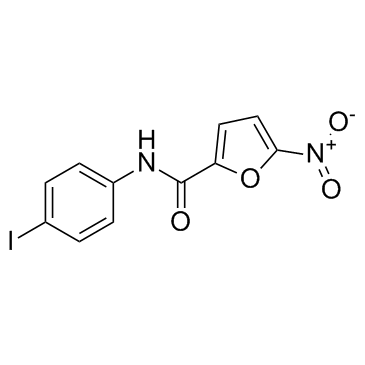C-176 (STING inhibitor 1) |
| Catalog No.GC33823 |
C-176 (STING inhibitor 1) is a strong and covalent mouse STING inhibitor.
Products are for research use only. Not for human use. We do not sell to patients.

Cas No.: 314054-00-7
Sample solution is provided at 25 µL, 10mM.
C-176 (STING inhibitor 1) strongly reduces STING-mediated, but not RIG-I- or TBK1-mediated, IFNβ reporter activity. It directly targets mouse STING (mmSTING) but not human STING (hsSTING)[1].
Cytotoxicity against human HCC1806 cells assessed as reduction in cell viability incubated for 3 days by cell-titer-Glo reagent based assay, IC50 = 6.2 µM. C-176 (STING inhibitor 1) induced apoptosis in HCC-1806 cells, C-176 (STING inhibitor 1) induced CHOP expression in HCC-1806 cells[2].STING was mainly distributed in microglia, and microglial STING expression was significantly increased after SAH. Administration of C-176 (STING inhibitor 1) substantially attenuated SAH-induced brain edema and neuronal injury. More importantly, C-176 (STING inhibitor 1) significantly alleviated both short-term and persistent neurological dysfunction after SAH[3].Inhibition of mmSTING by C-176 (STING inhibitor 1) enhanced type H vessels' formation, implying osteogenesis promotion in bone healing (higher bone volume density and more OCN-positive cells). STING inhibition accelerates the bone healing process while enhancing type H vessel formation[7].
C-176 (STING inhibitor 1) covalently binds to Cys91 of STING preventing activation via blockade of palmitoylation at Cys91. Treatment of Trex-/- mice with C-176 (STING inhibitor 1) resulted in a significant reduction in serum levels of Type I Interferons and amelioration of systemic inflammation[1]. When explored the molecular mechanisms of STING in regulating lipopolysaccharide (LPS)-induced lung injury. Mice were pretreated with a STING inhibitor C-176 (STING inhibitor 1) (15, 30 mg/kg) before LPS inhalation to induce ALI. LPS inhalation significantly increased STING expression in the lung tissues, whereas C-176 (STING inhibitor 1) pretreatment dose-dependently suppressed the expression of STING, decreased the production of inflammatory cytokines including TNF-α, IL-6, IL-12, and IL-1β, and restrained the expression of chemokines and adhesion molecule vascular cell adhesion protein-1 (VCAM-1) in the lung tissues[4].Genetic deletion of Sting in Apoe-/- mice reduced atherosclerotic lesions in the aortic arch, lipid, and macrophage accumulation in plaques, and inflammatory molecule expression in the aorta. Pharmacological blockade of STING using a specific inhibitor, C-176 (STING inhibitor 1), ameliorated atherogenesis in Apoe-/- mice[5]. Treatment with the STING inhibitor, C-176, suppressed EBV-induced transformation in peripheral blood mononuclear cells. In an EBV-LPD mouse model, C-176 (STING inhibitor 1) treatment also inhibited tumor formation and prolonged survival[6].
References:
[1]: Haag SM, Gulen MF, et,al. Targeting STING with covalent small-molecule inhibitors. Nature. 2018 Jul;559(7713):269-273. doi: 10.1038/s41586-018-0287-8. Epub 2018 Jul 4. PMID: 29973723.
[2]: Duan H, Li Y, et,al. Identification of 5-nitrofuran-2-amide derivatives that induce apoptosis in triple negative breast cancer cells by activating C/EBP-homologous protein expression. Bioorg Med Chem. 2015 Aug 1;23(15):4514-4521. doi: 10.1016/j.bmc.2015.06.011. Epub 2015 Jun 14. PMID: 26116180; PMCID: PMC5567983.
[3]: Peng Y, Zhuang J, et,al. Stimulator of IFN genes mediates neuroinflammatory injury by suppressing AMPK signal in experimental subarachnoid hemorrhage. J Neuroinflammation. 2020 May 25;17(1):165. doi: 10.1186/s12974-020-01830-4. PMID: 32450897; PMCID: PMC7247752.
[4]: Li Y, Su J, et,al. Targeted next-generation sequencing of deaf patients from Southwestern China. Mol Genet Genomic Med. 2021 Apr;9(4):e1660. doi: 10.1002/mgg3.1660. Epub 2021 Mar 16. PMID: 33724713; PMCID: PMC8123756.
[5]: Pham PT, Fukuda D, et,al. STING, a cytosolic DNA sensor, plays a critical role in atherogenesis: a link between innate immunity and chronic inflammation caused by lifestyle-related diseases. Eur Heart J. 2021 Nov 7;42(42):4336-4348. doi: 10.1093/eurheartj/ehab249. PMID: 34226923.
[6]: Miyagi S, Watanabe T, et,al. A STING inhibitor suppresses EBV-induced B cell transformation and lymphomagenesis. Cancer Sci. 2021 Dec;112(12):5088-5099. doi: 10.1111/cas.15152. Epub 2021 Oct 11. PMID: 34609775; PMCID: PMC8645724.
[7]: Chen X, He W, et,al. STING inhibition accelerates the bone healing process while enhancing type H vessel formation. FASEB J. 2021 Nov;35(11):e21964. doi: 10.1096/fj.202100069RR. PMID: 34694030.
Average Rating: 5 (Based on Reviews and 8 reference(s) in Google Scholar.)
GLPBIO products are for RESEARCH USE ONLY. Please make sure your review or question is research based.
Required fields are marked with *




